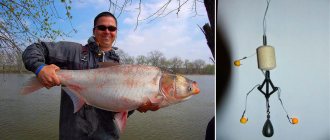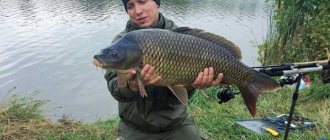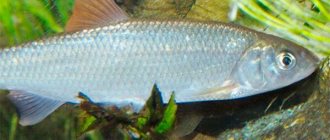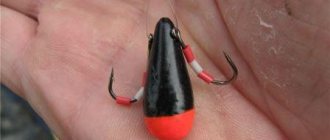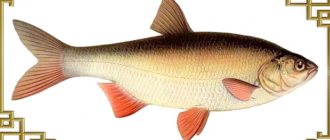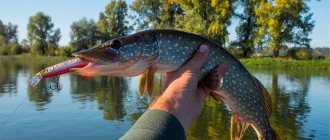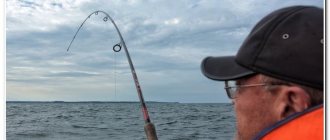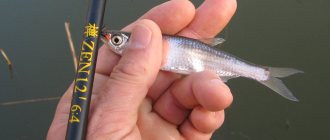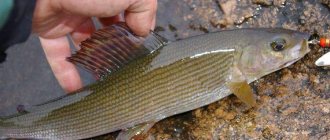Description and photo
Juvenile dace are similar to chub and ide. In contrast, adult dace are much smaller. The usual size of an adult dace is 18-22 cm, under favorable conditions it grows up to 33 cm. The weight of an adult dace is up to two hundred grams, in rare cases it reaches four hundred grams . The scales are medium. The structure of the mouth is semi-inferior, adapted for obtaining food from the bottom.
The body color is light silver, the back is dark, the belly is much lighter. The color of the fins is faded gray. In the western regions, a special subspecies of dace is common - andruga, which is distinguished by a dark stripe along the entire body.
Spawning of dace begins when the water warms up to 7-11 degrees , in the south - in March-April, in the northern regions a little later. Females spawn in places with a clean bottom, on sandy, silted-free soils.
Features of baits for dace
Content
Dace is a rather interesting species of vertebrate. The fish is distinguished by its agility and uncompromising resistance. But at the same time, the fish is not too picky, which makes the fisherman’s task easier. In this regard, do-it-yourself bait for dace should be simple and effective. Once in the water, the bait instantly attracts the attention of the fish and the latter has absolutely no need for exquisite “dishes”.
It is important to understand that complementary foods are not complete feeding, so the product should be offered to the dace along with clay or soil. The approximate amount of nutrients should be 30-40%, the rest is just an addition to the total mass.
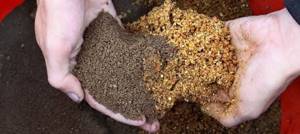
The bait mixture for dace must be mixed with soil
The simplest white bread is considered a win-win option for bait. Fish loves the aromatic smell and taste of baked goods. It is enough just to soften the product in water and make balls out of it (or stick small pebbles). You need to throw the bait to the point where you want to concentrate the fish in order to easily catch it in the future.
Some fishermen mix ground crackers with seeds and store the complementary food in dry form, after which they dilute the mixture with water with the addition of earth/clay on site.
After arriving and settling at the fishing site, you need to throw in complementary food in the amount of 4-6 balls made the size of an ordinary apple. You should periodically throw the prepared coma into the water. It is very important to try to keep the fish in the desired location for as long as possible. It is enough to add chopped worms and bloodworms to the prepared complementary food. It is also possible to enhance the aroma with cocoa.
Read more
Models and features of Yuzuri wobblers
Where does he live?
The dace lives in the waters of the rivers of central Russia, in the Urals, Siberia, and to the west - throughout the territory of Ukraine and Moldova. Due to the regulation of river flows and the formation of reservoirs, the number of dace in the west is steadily declining.
Dace is a distinct river fish that prefers clean running water, although it is also found in lakes. As a rule, it lives in the river in places with a gentle current , stands on shallows, behind rifts, below natural and artificial obstacles on the river, near the places where small streams enriched with oxygen flow into the river.
Shy and nimble dace, as a rule, stands far from sources of noise, places where people swim, on the border of open water and thickets of coastal algae, on spits, near riffles and holes, where the water is clean and the current is not very strong.
After the ice melts and rivers flood, dace come to flooded floodplains and floodplains, where they feed during daylight hours.
In the summer heat, when the water warms up to 21 degrees, flocks of dace move further from the shore, staying at half-water. At this time, the dace makes daily migrations from the surface of the water to the bottom in search of food.
In the upper layers of water, insects serve as food, as well as all edible particles floating on the surface.
With the arrival of autumn, when the water cools, the dace migrates to deep places and remains there until spring.
dace fishing spots
Dace overwinters in deep holes. In March it begins to move up the river.
Dace spawns very noisily, as it gathers in large flocks. Spawning occurs in early spring at a water temperature of 7°C. To spawn, it enters very shallow rivers, and sometimes even streams with insignificant depth, but with fast flow and clean water. The eggs are small and sticky. Hatching occurs after 10-12 days.
In summer, dace stays in schools below riffles, dams, and near pools in fast currents. Here he finds not only fresh water, but also food.
What does it bite on?
A variety of baits are used for catching dace. In the spring and early summer, when fishing near the bottom (with a float rod in the wire, with a donk, etc.), the following are perfect:
- small dung worms
- bloodworm
- maggot
With the arrival of July, when the water warms up, dace begins to be caught well on plant baits:
- dough
- bread
- steamed wheat grains
- pearl barley
When fly fishing, they catch with flies, grasshoppers, and artificial flies.
Winter bait
Preparing bait for dace in winter is not difficult. The recipes contain simple ingredients that every fisherman can get. It is important to focus on the season when going fishing, since under certain weather conditions the fish have special preferences and, with inappropriate bait, can bypass the fisherman.
Do-it-yourself winter bait for dace is the best option that will lead to successful fishing.
To prepare a trouble-free delicacy, we recommend using the following recipe:
- You will need two plastic bags, in one of them you should crumble the loaf, then pour boiling water over it. The second bag is filled with crushed peas mixed with millet.
- When fishing, as a rule, pebbles are used, they are covered with a bread mixture and dipped into a bag of peas and millet, making a kind of breading.
The finished balls are thrown into the holes, and they instantly swell. The dace reacts instantly to complementary foods and simply loves this delicacy.
It is recommended to make bait during winter fishing using crackers, seeds, vanillin and cocoa. The use of such a delicacy will help attract a large number of fish due to its pronounced aroma. Cocoa acts on dace like a drug.
Catching
Dace fishing is possible all year round. In open water, fishing begins in the spring, as soon as the ice melts and the water clears, until the end of October-beginning of November, before freeze-up. There are a variety of methods for catching dace:
- float gear in the wiring
- on a slowly sinking nozzle
- with a slope
- fly fishing with natural and artificial baits
Accordingly, the choice of gear will be different depending on the fishing method.
Fishing rod into the wiring
The most common and simplest way is fishing with a float rod in the wire. Gear for catching dace in this way must meet a number of requirements.
The rod chosen is light and elastic , up to 4 m, convenient for constant holding in the hands with frequent recasts. Main line with a diameter of up to 0.22 mm, leader 0.15 mm. The hook is small, No. 3.5-4, the length of the shank depends on the attachment used. The float is selected small, self-loaded or using a small sinker at a distance of at least 10 cm from the hook.
Whatever attachment is used when fishing with a retrieve, the tackle is adjusted so that the hook with the attachment goes at the very bottom
In this case, of course, frequent false hooks are inevitable, and the fishing process itself becomes very complicated. A careful dace is able to instantly and imperceptibly remove the bait from the hook, while the bite is masked by hooking the hook onto uneven bottoms.
You can raise the nozzle a little higher (2-6 cm) , but in this case the number of bites may decrease. It would be more correct to adapt to a specific place and study the bottom topography experimentally in order to understand where and how hooks will occur. The reward for patience will be stable bites of dace at the bottom. You should hook when the floating float stops and sinks by about a third. Therefore, the float tackle should be light, balanced and sensitive.
The hook should be fast, but not strong; it is better to do it with one hand, without jerking. Often, fishing with wires takes place by wading, so that it is possible to reach promising places with the tackle. But it should be remembered that dace is a sensitive and timid fish, so the noise and flapping of the gear can scare off a school.
Without float from the bottom
If the bite weakens or stops when fishing with a wire, you can try catching dace without a float, by pulling the nozzle. The float is removed and the sinker moves lower . The nozzle is thrown freely and sinks to the bottom. Then, after the line is pulled by the current, the tip of the rod slightly pulls the bait lying on the bottom against the current, simulating outgoing prey. The stretch is repeated five to six times. The point is to provoke the dace to bite, when the flock rushes after the departing bait.
From the surface of the water
In the summer, when insects begin to appear in the dace's diet, you can try fly fishing. For this method of fishing, places with a gentle current, rifts, spits, dams, ponds, wide places on the river where fish can stand, waiting for prey that has fallen into the water, are suitable. The bait is an ordinary fly, a small grasshopper, you can use insects that live near this particular body of water (mayfly, other flying insects).
As a rule, bites follow immediately if a school of dace feeds near the surface. If there is no bite, you can try fishing half-water or from the bottom. To do this, the nozzle needs to be weighted with a jig. The weight of the jig is selected so that the nozzle sinks at a natural speed. This way you can fish all layers, including the bottom one.
Donkoy
If the river is sufficiently wide, a donk with a roller can be successfully used. As a rule, when fishing in this way, the dace bite is different. The fish holds the bait for a while, pulling on the line until it feels resistance. Therefore, hooking when fishing with a bottom should be immediate after the first signs of a bite.
Fishing for hooked dace does not present any particular difficulties due to the size of the fish. If the hook is carried out correctly, there is little chance of a derailment. It is better to keep dace alive in spacious cages placed further from the shore on the current at the very bottom.
Tackle
Fishing in fast water requires strong, lightweight equipment. Choose a long, super light spinning rod. A test on a spinning rod is desirable up to 5 g. For spinning fishing, choose small spoons, preferably with a hook edge. Large dace displays predatory habits in the fall and will pursue such “trifles.” For a spinning rod you will need a light reel with good line laying.
The thickness of the fishing line should not exceed 0.1 mm. Monofilament would be a good choice. Do not forget that the dace has a fragile lip, and a strong hook can leave you without prey.
You can't go wrong if you choose a medium rod that bends well. The fishing line can be the same as described above. The float should not be heavy , but as stable as possible, sporty, capable of maintaining the vertical position of the antenna even when the tackle is completely stopped. Many people are not comfortable using a fishing rod and reel; the cast when fishing for dace does not exceed 4-5 meters.
Are you interested in catching ide in the fall? The article will show the basic techniques for catching this fish.
In this article you will learn how to catch burbot on a donka in the autumn.
The dace bites well on a jig in the form of an artificial ant, but does not ignore simple “droplets” or “bugs”. Setting the diving depth should allow the bait to go almost to the bottom. To more accurately catch the moment of a bite, place several (two or three) small sinkers from the middle down.
This will allow the float to rise vertically before the bait reaches its final depth.
The dace bite is fast , it approaches the target from the bottom (the habit of catching prey falling from above), so you must be ready.
Dace move
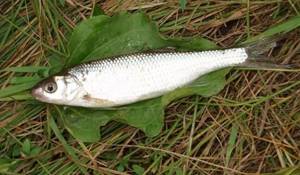
The dace, despite its modest size, has long earned a reputation among fishermen as a sport fish. Fishing with fly fishing, with a float rod, and in recent years, with a spinning rod on an ultralight has a large number of fans.
This fall I was lucky enough to catch a massive movement of it - from small rivers it rolled down to Chulym, to its wintering place. In general, over the years of living in Siberia, I noticed several features in the behavior and lifestyle of the local dace. By the way, they call it here in some places not only dace, but also “megdym” and “chebak” (the latter causes some confusion with roach, which is also called “chebak” here).
In some taiga rivers he lives sedentary, all year round. In the summer and in the first half of autumn, it stays on the rifts, the boundaries of the reaches, and with the onset of cold weather it goes into the pool, from where, however, it periodically comes out to feed even in winter, especially towards its end. Other dace stay in small rivers in the summer, and in the fall they begin to move into large rivers, joining the local ones and spending the winter with them. These are not caught until spring. I managed to catch such a period of fish rolling into Chulym from an unnamed river.
At the time of such a move, he bites almost all day, especially if it is a fine day. My fishing gear is the simplest - a regular 5-meter fishing rod with a 0.18 line and a 0.12 mm leash. The equipment is simple - a sensitive float, at the end of the fishing line - instead of a hook and sinker - a jig. The dace takes any jig - at first I had a copper “eye”, and after the break - a lead “Uralka”. There is no difference.
At the confluence of the nameless river - and essentially a stream - into the Chulym, I settled down. This fishing is very simple and exciting - casting into the current, followed by an almost instantaneous bite, hooking and now a lively “little chub” is in your hands. If there is no bite, then at the end of such a wiring cycle, when the current pulls out the line, it makes sense to do a “control” hook. Often the dace takes the jig “on the fly.” By the way, it takes it quite thoroughly; at times you have to tinker with removing the jig from the fish’s mouth.
Unlike summer fishing, when you have to frequently change your location, here I fished almost all day in one place, only occasionally moving to the sides by 15-20 meters. Sometimes we had to go into the water in fords.
The catch is dominated by dace weighing 100-150 grams, but from time to time you come across larger specimens - these are real trophies. Along the way, there are also roaches weighing 400-500 grams, the landing of which is a particular pleasure. Once, apparently, a real ide landed - he tore off the jig, I was simply not mentally prepared to fight with a large fish.
At first I fished with grasshoppers, but when they ran out, I decided to try a worm. The result was almost the same. Of course, such fishing cannot be compared with hunting predatory fish, but it has its own charm. At some point, you are overcome with primitive excitement, you want to catch more and more. Moreover, such a massive movement lasts only a few days a year. So getting on it is real luck!
I don’t even know what signs you need to navigate by - the fish has its own calendar. But usually it's September. Sometimes it’s in the middle, but this year it’s towards the end of the month. The daily catch was almost 8 kg - this is my absolute record for dace. This kind of fishing is a kind of farewell to the summer float fishing season, its final chord, which will be remembered for a very long time. What to do with such a mass of fish? First of all, of course – smoke! Autumn fatty hot smoked dace is a true delicacy!
Pavel Lagutin talked about his fishing.
Description of dace
In general, when we began to describe this fish, which is extremely similar to chub, some doubt initially arose as to whether it was worth talking about dace at all. But due to the fact that dace inhabits most of our rivers and lakes (flowing), it bites very actively almost from spring to late autumn, and its size can reach the palm of an adult with a weight of 150-200 grams (and this, you see, is no longer not enough), then all the questions disappeared by themselves. Elets definitely deserves attention, because in addition to its sporting interest, it is oh so good in culinary terms.
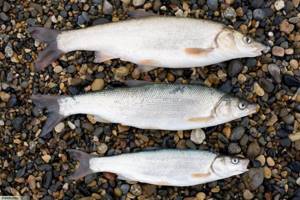
So, first just a few words about this fish, and then about how and where to catch it.
Dace belongs to the cyprinids, while, as some sources indicate, dace is a long-lived fish (unless, of course, it becomes prey for pike, it can live more than 8-11 years). Fishermen’s catches most often come across specimens no larger than ten centimeters, but if you’re lucky, you can catch a much larger specimen. Like many fish, the back of the dace has a darker color (gray-blue tint), and light white shades predominate on the ventral side. The scales are silvery in color, relatively large, the body is compressed laterally, the powerful caudal fin is dark in color. How can you tell if you are looking at a dace or a chub? There are many signs, but in our practice we use one - the color of the anal fins, which in the chub have a clear reddish tint. Well, as we have already noted, the dace is more compressed from the sides, and the chub spreads slightly to the sides. Knowing this, it is difficult to confuse these fish with each other, the main thing is not to forget what is characteristic of each.
What are we talking about?!
We talked about dace very briefly, giving, so to speak, the basics. But what’s interesting is that if you learn to catch dace, camouflage yourself on the shore, keeping quiet and careful, you can be sure that you have already achieved a certain skill in fishing. Dace, namely its successful catching, in our opinion, is one of the indicators of professionalism and fishing skill, since it is very difficult to catch this fish just by accident.
Good luck to you and all the best.
I recommend to read:
Places and methods of catching ide
Share with your friends!
